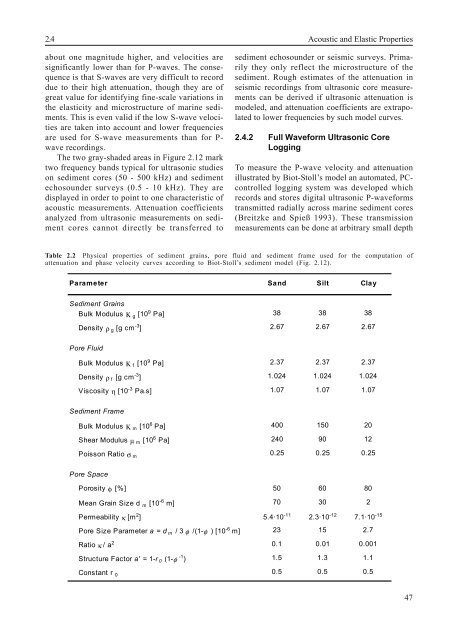2 Physical Properties of Marine Sediments - Blogs Unpad
2 Physical Properties of Marine Sediments - Blogs Unpad
2 Physical Properties of Marine Sediments - Blogs Unpad
Create successful ePaper yourself
Turn your PDF publications into a flip-book with our unique Google optimized e-Paper software.
2.4 Acoustic and Elastic <strong>Properties</strong>about one magnitude higher, and velocities aresignificantly lower than for P-waves. The consequenceis that S-waves are very difficult to recorddue to their high attenuation, though they are <strong>of</strong>great value for identifying fine-scale variations inthe elasticity and microstructure <strong>of</strong> marine sediments.This is even valid if the low S-wave velocitiesare taken into account and lower frequenciesare used for S-wave measurements than for P-wave recordings.The two gray-shaded areas in Figure 2.12 marktwo frequency bands typical for ultrasonic studieson sediment cores (50 - 500 kHz) and sedimentechosounder surveys (0.5 - 10 kHz). They aredisplayed in order to point to one characteristic <strong>of</strong>acoustic measurements. Attenuation coefficientsanalyzed from ultrasonic measurements on sedimentcores cannot directly be transferred tosediment echosounder or seismic surveys. Primarilythey only reflect the microstructure <strong>of</strong> thesediment. Rough estimates <strong>of</strong> the attenuation inseismic recordings from ultrasonic core measurementscan be derived if ultrasonic attenuation ismodeled, and attenuation coefficients are extrapolatedto lower frequencies by such model curves.2.4.2 Full Waveform Ultrasonic CoreLoggingTo measure the P-wave velocity and attenuationillustrated by Biot-Stoll’s model an automated, PCcontrolledlogging system was developed whichrecords and stores digital ultrasonic P-waveformstransmitted radially across marine sediment cores(Breitzke and Spieß 1993). These transmissionmeasurements can be done at arbitrary small depthTable 2.2 <strong>Physical</strong> properties <strong>of</strong> sediment grains, pore fluid and sediment frame used for the computation <strong>of</strong>attenuation and phase velocity curves according to Biot-Stoll’s sediment model (Fig. 2.12).Parameter Sand Silt ClaySediment GrainsBulk Modulus Κ g [10 9 Pa] 38 38 38Density ρ g [g cm -3 ] 2.67 2.67 2.67Pore FluidBulk Modulus Κ f [10 9 Pa] 2.37 2.37 2.37Density ρ f [g cm -3 ] 1.024 1.024 1.024Viscosity η [10 -3 Pa⋅s] 1.07 1.07 1.07Sediment FrameBulk Modulus Κ m [10 6 Pa] 400 150 20Shear Modulus µ m [10 6 Pa] 240 90 12Poisson Ratio σ m0.25 0.25 0.25Pore SpacePorosity φ [%] 50 60 80Mean Grain Size d m [10 -6 m] 70 30 2Permeability κ [m 2 ] 5.4·10 -11 2.3·10 -12 7.1·10 -15Pore Size Parameter a = d m /3φ /(1-φ ) [10 -6 m] 23 15 2.7Ratio κ / a 2 0.1 0.01 0.001Structure Factor a' = 1-r 0 (1-φ -1 ) 1.5 1.3 1.1Constant r 00.5 0.5 0.547
















